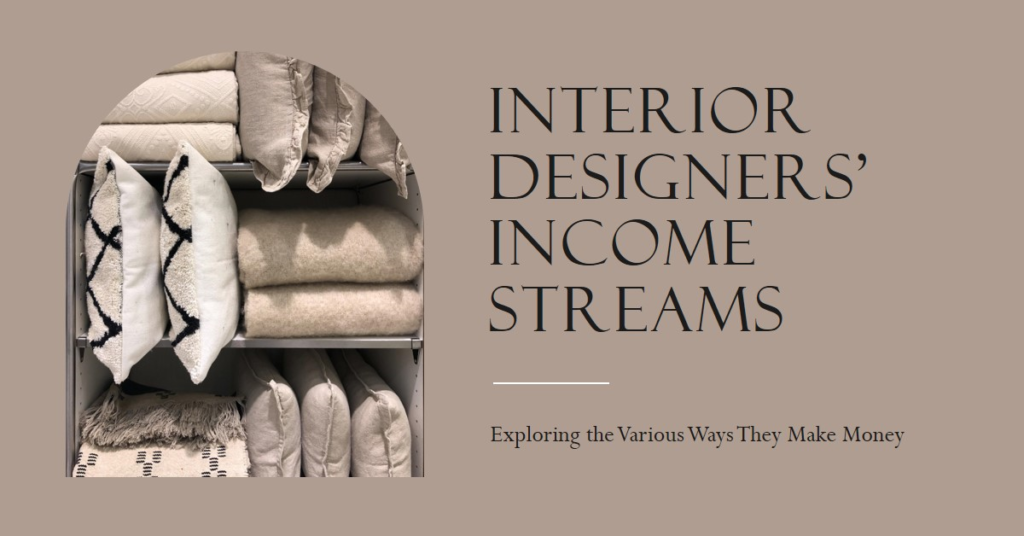
Table of Contents
- Introduction
- 1. Client Consultations: The Foundation of Design Services
- 2. Project Management: Steering the Design Process
- 3. Design Fees: Charging for Creativity
- 4. Retail Markup: Profit from Product Selection
- 5. Affiliate Programs: Earning Through Recommendations
- 6. Online Courses and Workshops: Sharing Expertise
- 7. Licensing and Royalties: Capitalizing on Design
- 8. Writing and Publishing: Becoming an Authority
- 9. Television and Media Appearances: Showcasing Talent
- Conclusion: Diversifying Income for Sustainable Success
Introduction
Interior design is a multifaceted profession that encompasses creativity, technical skills, and a deep understanding of clients’ needs. Successful interior designers often have a knack for turning spaces into functional works of art, but how do they translate their talents into income? In this blog post, we will explore the myriad ways interior designers can generate revenue, shedding light on the diverse opportunities available in this vibrant industry.
1. Client Consultations: The Foundation of Design Services
One of the primary ways interior designers make money is through client consultations. This initial phase is crucial as it sets the stage for the entire project. During consultations, designers assess the client’s needs, preferences, and budget, providing valuable insights and professional advice.
Typically, designers charge an hourly fee for these sessions. The rates can vary widely based on experience, reputation, and location. Some designers offer a complimentary first consultation to attract clients, while others may charge a premium for their time and expertise. This revenue stream not only compensates for the designer’s time but also helps in building a strong client relationship.
2. Project Management: Steering the Design Process
Once the consultation phase is complete, many designers take on the role of project managers. This involves overseeing the entire design process from concept to completion. Effective project management ensures that projects stay on schedule and within budget, which is critical for client satisfaction.
Project management fees are typically a percentage of the total project cost. This percentage can range from 10% to 25%, depending on the complexity and scale of the project. By handling logistics, coordinating with contractors, and managing timelines, designers add significant value, justifying their fees.
3. Design Fees: Charging for Creativity
Interior designers also generate income through design fees, which cover the creation of detailed design plans and concepts. These fees compensate for the designer’s creative input and expertise in crafting aesthetically pleasing and functional spaces.
Design fees can be structured in various ways. Some designers charge a flat fee for the entire project, while others bill hourly. Another common approach is to charge a fee per square foot. Regardless of the method, design fees are a substantial part of an interior designer’s income, reflecting the value of their creative vision.
4. Retail Markup: Profit from Product Selection
Another lucrative revenue stream for interior designers is retail markup. Designers often source furniture, fixtures, and accessories for their clients, purchasing these items at trade or wholesale prices. They then sell the products to clients at retail prices, earning a profit on the difference.
This practice not only adds to the designer’s income but also allows them to offer clients exclusive products that may not be available to the general public. The markup percentage can vary, but it typically ranges from 10% to 40%, depending on the product and the designer’s agreement with the client.
5. Affiliate Programs: Earning Through Recommendations
In today’s digital age, affiliate marketing has become a significant income source for many interior designers. By partnering with brands and retailers, designers earn commissions on products their clients purchase through their recommendations or affiliate links.
Affiliate programs provide a passive income stream, as designers can promote products through their websites, social media, and other marketing channels. The commission rates vary by brand but generally range from 5% to 20%. This strategy not only enhances a designer’s income but also aligns with their role as trendsetters in the industry.


6. Online Courses and Workshops: Sharing Expertise
Many interior designers monetize their knowledge by offering online courses and workshops. These educational programs cater to aspiring designers, DIY enthusiasts, and even seasoned professionals looking to upgrade their skills.
By creating and selling courses on platforms like Udemy, Skillshare, or their websites, designers can reach a global audience. Additionally, live workshops and webinars provide interactive learning experiences, often commanding higher prices. This educational approach diversifies income and establishes designers as thought leaders in their field.
7. Licensing and Royalties: Capitalizing on Design
Some interior designers extend their creative reach by licensing their designs to manufacturers and retailers. This can include everything from furniture and textiles to wallpaper and home decor items. Licensing agreements allow designers to earn royalties on the sales of their designs, providing a steady stream of passive income.
Royalties are typically a percentage of the sales revenue, ranging from 3% to 10%. This income source not only enhances a designer’s financial portfolio but also broadens their brand recognition and market presence.
8. Writing and Publishing: Becoming an Authority
Another way interior designers can earn money is through writing and publishing. By authoring books, writing articles for design magazines, or maintaining a popular blog, designers can establish themselves as authorities in the industry.
Books and e-books on design principles, trends, and how-to guides can generate significant revenue, especially when coupled with speaking engagements and book tours. Additionally, regular contributions to design publications and websites can provide ongoing income and enhance a designer’s credibility and visibility.
9. Television and Media Appearances: Showcasing Talent
Television shows and media appearances offer high-profile opportunities for interior designers to showcase their talent. Designers who become hosts or experts on home improvement and design shows can earn substantial income while reaching a wide audience.
These appearances can lead to additional revenue streams, such as product endorsements and sponsored content. Being in the public eye also enhances a designer’s brand, attracting more clients and higher-profile projects.
Conclusion: Diversifying Income for Sustainable Success
The interior design industry offers a wealth of opportunities for designers to monetize their skills and creativity. By diversifying their income streams through consultations, project management, design fees, retail markup, affiliate programs, online courses, licensing, writing, and media appearances, designers can build a sustainable and lucrative career.
Each revenue stream requires a different set of skills and strategies, but together, they provide a comprehensive approach to financial success in the competitive world of interior design. Embracing these opportunities allows designers to not only thrive financially but also continuously grow and innovate in their craft.


